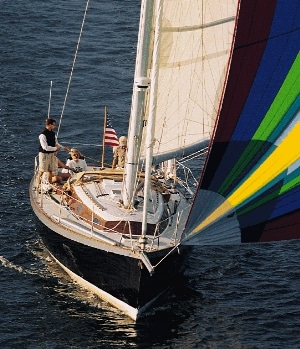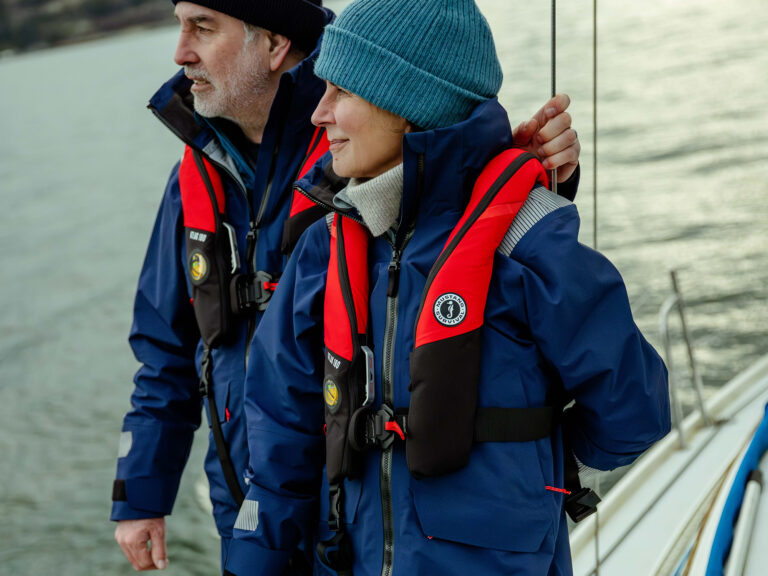
graywolf.gif
Gray Wolf’s designer Rodger Martin has drawn a cruising boat that at first glance appears conventional and slightly conservative but is in reality a powerhouse brimming with innovation and radical thought. Her construction derives from advanced design technology and from simple solutions to sophisticated requirements. She has a pleasing appearance built into a very functional shape. None of this is surprising given Martin’s enduring association with long-distance singlehanded yacht-racing design, a career in which we’ve seen him produce the likes of BOC giants Airco Distributor, Grinaker, Duracell, and Coyote. Gray Wolf’s more exciting features include a hull constructed using WEST epoxy and strip-planked red cedar, an unstayed carbon mast, integral water ballast tanks to level the boat and increase sail-carrying ability, a plumb bow and stern providing maximum waterline length, and a deep fin keel with attached bulb to ensure stability and superior sailing qualities. These features are not often found on a cruising boat, but their effective use on Gray Wolf results in a vessel that is fast, easy to sail and immensely strong.
I spent a day with Rodger sailing aboard Gray Wolf on Rhode Island’s Narragansett Bay in a light chop with winds westerly at 15 to 18 knots. Our initial angle of heel, close reaching with a full main and 120-percent jib, was near 10 degrees. This all but disappeared after Rodger scurried below and switched on a Rule 3600 pump to fill the windward ballast tank. Our speed subsequently increased by a knot, to say nothing of our comfort level.
Movable water ballast is embraced heartily in the context of race boats, but its use is so simple and its results so dramatic that it can no longer be dismissed from the cruising-boat arena. On Gray Wolf the ballast tanks are not obvious or intrusive. They are built into otherwise unusable space amidships, outboard of the galley, nav station and quarter berth. Each port and starboard tank holds 262 gallons (2,240 pounds), and is divided into thirds using internal baffles to prevent water from sloshing when the tanks are partially filled. A Lexan “view port” allows quick determination of the amount of water inside, and my only suggestion for improving these tanks would be to insert a rubber duck or an exotic fish into each one.
Gray Wolf’s displacement is a light 13,000 pounds, but this low weight does not indicate light scantlings. Weight has been kept down using both an innovative epoxy-strip plank construction technique and by not burdening the hull with unnecessary hardware or fittings. Prior to construction Martin and naval architect Steve Koopman designed eight different composite panels, all the same weight, for testing by Gougeon Brothers. Results showed that a panel consisting of one-inch strip-planked Western red cedar covered with biased cloth and epoxy resin gave the best combination of strength, stiffness and weight.
Gray Wolf’s builder, Lyman Morse, constructed the boat so that the wood component is clearly visible inside the hull, giving a warm and pleasing feeling to the interior. Strength in the deck and cabin top comes from marine plywood, balsa, epoxy resin and close-spaced laminated beams. Vacuum-bagging was used to ensure proper saturation and adhesion.
Interior weight and construction costs have been kept low by keeping bulkheads to a minimum; those needed are built from cored panels. Even the cabin floorboards are cored with balsa to reduce weight, with no loss of strength. Though simple and unadorned below, the interior does not appear spartan or unfinished. Instead it has the sophistication and simplicity of a refined Japanese rock garden.
Gray Wolf is a well-balanced boat. Using a flexible extension on the six-foot laminated tiller, a helmsman can sit on the cockpit’s generous side decks and sail her just as one would sail a dinghy. At speeds between 7 and 9 knots, she tacks and jibes quickly and decisively, always under control. Sail changes and sail reductions can be completed handily from the cockpit by way of an array of color coded lines and Antal stoppers, a double-ended mainsheet and adjustable sheet car leads.
The carbon mast, boom and seven-foot bowsprit were built by Composite Engineering of Concord, Massachusetts. The mast is freestanding with the exception of a headstay and running backstays. A mainsail groove and gooseneck fitting are built into the mast wall. A standard sail plan of 1,110 square feet divided between a fully battened mainsail and 120-percent genoa enables the boat to go upwind with ease. An asymmetrical spinnaker or working jib can be flown off the seven-foot centerline bowsprit, and in combination with the large full-batten mainsail, given the right conditions, this will put Gray Wolf up on a plane in a heartbeat.
The hull is supported by laminated mahogany frames on 3-foot centers with additional floors in the area of the keel. Keel attachment is through a solid fiberglass sump scarfed into the strip-planked hull. Gray Wolf’s keel is an airfoil-shaped steel fin with an attached lead bulb and a seven-foot, six-inch draft; it provides excellent stability and prevents the snap rolling often felt on shoal-draft designs.
A 37-foot waterline on a 40-foot overall length provides a theoretical hull speed of approximately 8.5 knots. This speed is easily achieved and routinely exceeded because, even though Gray Wolf is a displacement boat, it has a planing hull shape aft and a fine entry that pushes a minimum of water. A 12-foot 10-inch beam, one-third of the boat’s length, provides great initial stability and enables force generated by the sails to be translated into forward motion.
In short, Gray Wolf is a design whose time has come. It effectively and appropriately uses water ballast, a planing hull and a deep fin keel to yield a fast, safe and exciting cruising concept.
Gray Wolf Specifications:
- LOA 40’0″
- LWL 36’6″
- Beam 12’10”
- Draft 7’6″
- Disp 13,500 lbs.
- Ballast 4,500 lbs.
- Water ballast 2,240 lbs.
- SA (100%) 900 sq.ft.
- Disp/Length 124
- SA/Disp 25.4
Rodger Martin Yacht Designs
Box 242
Newport, RI 02840
Phone:(401) 849-9850








